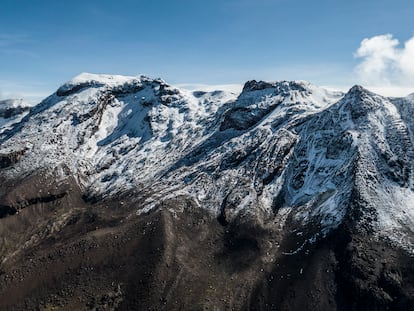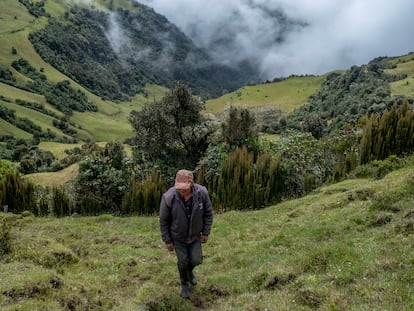Mexico’s Popocatépetl volcano activity mobilizes the army in the event of a possible evacuation
The Ministry of National Defense assigns 6,000 troops to assist more than 125,000 people in Puebla, State of Mexico, Morelos and Tlaxcala, in the center of the country


The Ministry of National Defense (Sedena) has deployed 7,275 Army troops to assist the more than 125,000 people living in the municipalities of Puebla, Tlaxcala, Morelos and the State of Mexico, in the center of the country, near the Popocatepetl volcano, in case an evacuation is necessary. At present, the volcano’s activity remains at Yellow Phase 3, which means that the population does not have to leave their homes yet.
President Andrés Manuel López Obrador assured during Monday’s daily morning press conference that Civil Protection is monitoring the activity of the ‘Popo’ volcano 24 hours a day and that there is coordination between the three levels of government to monitor the volcano’s activity. The governor of Puebla, Sergio Salomón, meanwhile, has asked the population to remain away from the volcano within a radius of 12 kilometers and to avoid leaving their homes.
Of the total number of troops, more than 5,000 come from military zones 23, 24, 25 and 37, located in Morelos, Puebla, Tlaxcala and Pachuca. Another 1,500 troops are part of the Emergency Task Force of the Valley of Mexico. The president has confirmed that nine evacuation routes are planned in the event of an emergency and several shelters to house the displaced are ready to be set up. The Secretary of Sedena, Luis Crescencio Sandoval, has traveled to Puebla to head the operation along with Civil Protection. López Obrador has asked the population to remain calm and to follow the instructions of state and municipal authorities at all times. The National Guard has also mobilized troops to support nearby communities.
The Secretary of Civil Protection, Laura Velázquez Alzúa, clarified that at the moment there is no emergency, but that due to the increase in the volcano’s activity and the change from Phase 2 to Phase 3 Yellow Alert, it is necessary for the authorities to be prepared. She also indicated that all civil protection systems at the state and local level must take extreme precautions. Velázquez said in a press conference that as of Sunday, 573 explosions had been recorded, 70% of which were minor.
In the early hours of Monday, the quakes and the emission of ash and of water vapor remained constant. The National Center for Disaster Prevention (Cenapred) reported that incandescent material continues to come out of the crater along with a smoke column 1,600 meters high which is moving in an east-northwest direction. Emissions from the volcano have affected the air quality of the city of Puebla, which has had a high concentration of PM-10 and PM-2.5 particles for 24 hours. Air pollution levels are currently double and triple the levels recommended by the World Health Organization (WHO). Authorities recommend the population to wear masks if they leave the house, not to engage in outdoor activities, and classes have been suspended.
Local authorities report that 40 municipalities in Puebla, five in the State of Mexico and seven in Tlaxcala will not have classes. The Ministry of Education (SEP) informed that students will be able to study these days remotely through the Aprende en Casa platform, available through television, internet and YouTube. Authorities have asked the entire education community to follow the indications of the National Coordination of Civil Protection, the Federal Health Secretariat and the education authorities of the affected states.
The effects of Popocatepetl’s activity also reach Mexico City, the capital, two hours from Puebla. For the third consecutive day, Mexico City International Airport (AICM) and Felipe Angeles Airport (AIFA) have cancelled dozens of flights due to ash fall from the volcano. Aeromexico has suspended 50 flights and Viva Aerobus has recommended its users on social networks to keep an eye on their travel updates because they could be affected.
Volcanologist Hugo Delgado Granados of the National Autonomous University of Mexico (UNAM) explained in a recent interview with EL PAÍS that Popocatépetl erupts about every 70 years. This period, of approximately seven decades, coincides with its last phase of eruptive activity, which began in 1919 and lasted until 1927. From then on, the ‘Popo’ entered a resting phase that lasted for most of the 20th century, until 1993, when it again increased its eruptive phase with a series of explosions on December 21, 1994, which forced the first modern evacuation in the surrounding municipalities.
Sign up for our weekly newsletter to get more English-language news coverage from EL PAÍS USA Edition
Tu suscripción se está usando en otro dispositivo
¿Quieres añadir otro usuario a tu suscripción?
Si continúas leyendo en este dispositivo, no se podrá leer en el otro.
FlechaTu suscripción se está usando en otro dispositivo y solo puedes acceder a EL PAÍS desde un dispositivo a la vez.
Si quieres compartir tu cuenta, cambia tu suscripción a la modalidad Premium, así podrás añadir otro usuario. Cada uno accederá con su propia cuenta de email, lo que os permitirá personalizar vuestra experiencia en EL PAÍS.
¿Tienes una suscripción de empresa? Accede aquí para contratar más cuentas.
En el caso de no saber quién está usando tu cuenta, te recomendamos cambiar tu contraseña aquí.
Si decides continuar compartiendo tu cuenta, este mensaje se mostrará en tu dispositivo y en el de la otra persona que está usando tu cuenta de forma indefinida, afectando a tu experiencia de lectura. Puedes consultar aquí los términos y condiciones de la suscripción digital.
More information

The death of the last glaciers in Mexico

Refusing to evacuate, residents near a smoking Colombian volcano watch and wait
Archived In
Últimas noticias
Most viewed
- Sinaloa Cartel war is taking its toll on Los Chapitos
- Oona Chaplin: ‘I told James Cameron that I was living in a treehouse and starting a permaculture project with a friend’
- Reinhard Genzel, Nobel laureate in physics: ‘One-minute videos will never give you the truth’
- Why the price of coffee has skyrocketed: from Brazilian plantations to specialty coffee houses
- Silver prices are going crazy: This is what’s fueling the rally








































